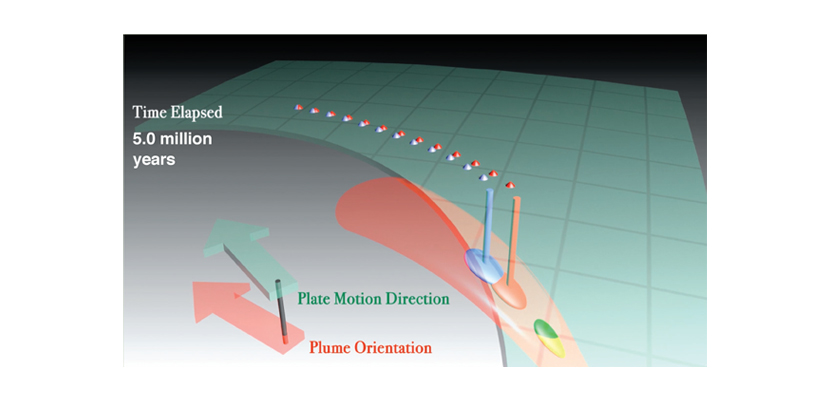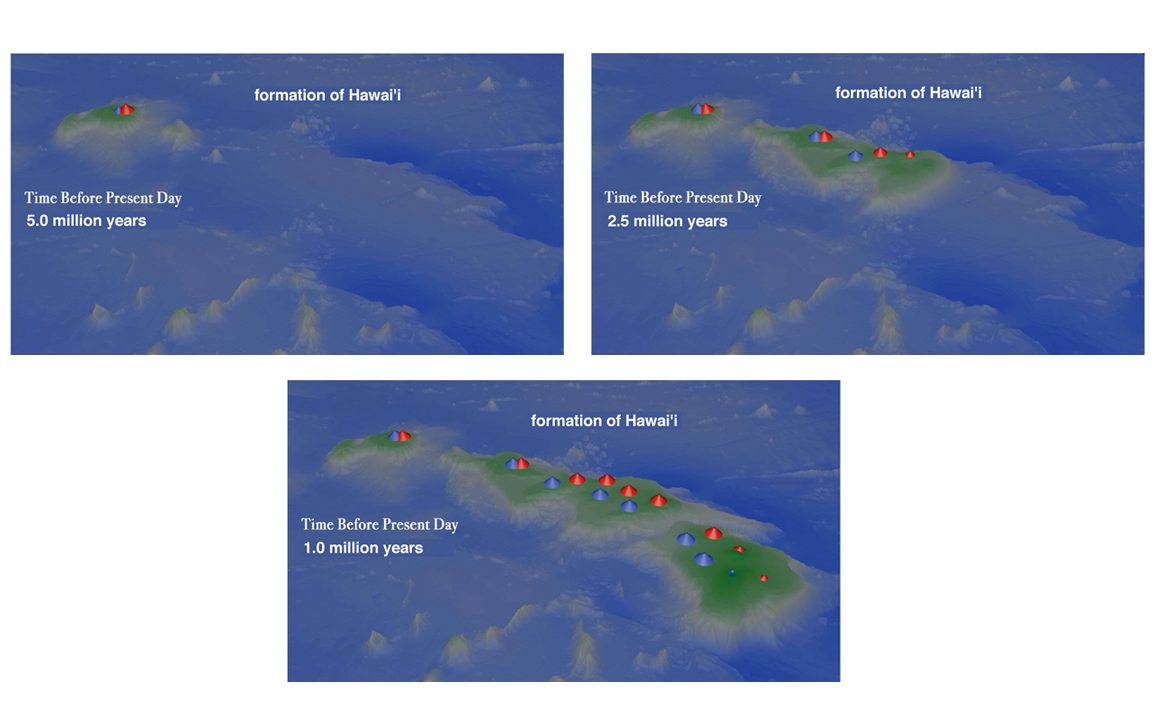A Slow Split
By Robert Frederick
The volcanic hotspot forming the Hawaiian islands split into two tracks millions of years ago, but why?
The volcanic hotspot forming the Hawaiian islands split into two tracks millions of years ago, but why?

Soon after cartographers in the 19th century accurately captured the relative locations of Hawai'i's volcanoes, they observed that the volcanoes lie on separate, roughly parallel tracks. For more than a century, the question of how those tracks occurred has intrigued geologists, who have since learned much more about double-tracked volcanoes, which have formed at several other places in the Pacific, too.
"What we recognized," says Tim Jones, a doctoral student in the Research School of Earth Sciences at Australian National University, "was that all the double tracks that occur in the Pacific occur around the same time. They emerged simultaneously," which, in geological time scales, is between 2 and 4 million years ago.
Having teamed up with geoscientists from around the world, Jones then worked to model the only thing that could account for the existence of multiple instances of double- tracked volcanoes: Around 3 million years ago, Earth's largest tectonic plate—the basin for the Pacific Ocean—started to change direction.

It wasn't the first time this tectonic shift had occurred. Scientists first proposed in 1963 that the Pacific plate took a sharp westerly turn about 40–50 million years ago, assuming that the hotspot beneath today's Hawaiian islands itself has remained stationary. Sonar of the ocean floor showed scientists at the time a straight line of seamounts connecting the Hawaiian islands to the Midway Atoll. That line extends to Yurikaku Seamount and then makes a sharp turn to join the Emperor chain of seamounts, which extends thousands of kilometers northward to the Aleutian trench.
Today, geologists also are equipped with data from the Global Positioning System, core drilling, seismology, and mass spectroscopy, among other sources. To tie all that data together, Jones and his colleagues created a computer model that also needed to account for the observed difference between the chemical composition of lava erupting from the volcanoes in each track.
"All other previous explanations had invoked some change in the mantle," Jones says, with the scientific consensus being that the Hawaiian hotspot forms from magma rising from near the mantle-core boundary 3,000 kilometers down. "But there was no mechanism that would link these different processes to such widespread locations," namely, the locations of the other double-tracked island chains.

The model Jones's team created takes into account the directional shift of the Pacific plate, the mantle plume reorientation that lags behind that directional shift, and the proposition that lava composition varies based on where the magma comes from: Kea-trend magma forms deep within in the Earth's mantle at higher pressure and temperatures, burning the hole in the Earth's crust that initiates the next volcano in the chain; as the tectonic plate moves over the melted zone, Loa-trend magma rises from shallower levels in the mantle.
So as long as the plate direction is aligned with the plume orientation, both types of magma erupt from approximately the same location. At Kaua'i—a volcanic island formed before the split—analyses of deep core samples support the hypothesis: Initial Kea-type basalts are covered over by Loa-type basalts. A tectonic shift, however, may cause the sequential magma flows to form volcanoes at different geographic locations, forming two tracks. As plate direction stabilizes, the mantle plume reorients to match and the two tracks will merge back into one. The team published their research in the May 25 issue of Nature.

To further confirm the hypothesis, Jones says that samples from the other double-track volcanic chains, in which the chemical composition of lava already has been shown to vary for each track, need to be analyzed to see whether that variation signals the same geologic processes hypothesized to be at work in Hawai'i's double track.
"We need also to look back along these very long chains and find out where else these double tracks have emerged in the past," Jones says. "If we can link up those with more changes in plate motion, then we can be more confident that there is a causal relationship between the changes in plate motion and the emergence of double tracks."
Whether or not the hypothesis holds, analyzing the compositional differences in magma from these double-tracked volcanoes is helping geologists better understand the processes deep within Earth's mantle, something that can only be sampled from here at the surface.
Click "American Scientist" to access home page
American Scientist Comments and Discussion
To discuss our articles or comment on them, please share them and tag American Scientist on social media platforms. Here are links to our profiles on Twitter, Facebook, and LinkedIn.
If we re-share your post, we will moderate comments/discussion following our comments policy.